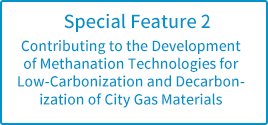Special Feature 1: Starting a Verification Project to Establish a Virtual Power Plant (VPP) Using a Residential Fuel Cell, “ENE-FARM”


Technology that Contributes to the SDGs
Electricity cannot be stored, so continual adjustments of power generation must be made to ensure a balance between supply and demand. If power generation is not balanced, the frequency of the electricity will fluctuate, potentially resulting in large-scale power outages, in the worst-case scenario. As a result, general electricity transmission and distribution utilities currently maintain frequencies within a certain range, mainly by limiting the output of power stations to match demand.
Renewable energy, which does not generate CO2 when electricity is generated, may become a key energy source in future under Japan’s energy policies. Still, solar power generation and wind power generation are affected by weather conditions such as the amount of solar radiation and strength of the wind, causing issues when adjusting the balance of grid electricity supply and demand.
On the other hand, fuel cells characteristically enable free control of the output power, and are attracting attention as a resource that can contribute to adjustment of grid electricity supply and demand in a society in which a large amount of renewable energy is introduced.

Innovation by the Daigas Group
Osaka Gas is conducting a verification project to build a virtual power plant (VPP)*1by controlling approximately 1,500 units of residential fuel cells, “ENE-FARM type S (equipment sold after April 2018),” installed at customers’ homes (the total rated output reaches around 1 MW*2) as energy resources as if they are a single power plant, so as to utilize it for effective adjustment of grid electricity supply and demand. While the aggregation coordinator*3 in this verification project is Chubu Electric Power Miraiz Co., Inc., Osaka Gas participates in the project as a resource aggregator*4.
We have installed the IoT function on our products starting at the “ENE-FARM type S*5 ,” which was released in 2016, and approximately 50,000 units*6 are currently connected to the server of Osaka Gas. We will verify that the output power of “ENE-FARM” can be controlled in accordance with the grid supply and demand situation, including the output fluctuation of renewable energy, by utilizing the know-how of remote control technology cultivated through the efforts to realize IoT applications.

- *1 Virtual power plant. It is realized by business operators called “aggregators” using, in a bundle, the adjustment power supplied by distributed power sources.
- *2 If the rated power output of “ENE-FARM” is estimated to be 700 W, the total rated power output of 1,500 units of “ENE-FARM” will be 1,050 kilowatts ≈ 1 MW.
- *3 A business operator who aggregates the electric power controlled by a resource aggregator, and trades electricity directly with general electricity transmission and distribution utilities and electricity retailers
- *4 A business operator who controls resources by directly concluding VPP service contracts with customers
- *5 A device that directly generates electricity through the chemical reaction between hydrogen and oxygen. It generates electricity continuously for 24 hours according to the amount of electricity used at each house. Meanwhile, the heat generated during power generation can be used for hot water supply and storage in a tank.
- *6 As of May 31, 2020
- Management Plan
- Management Plan Documents Long-Term Management Vision2030/Medium-Term Management Plan 2026
- Daigas Group's Values
- Daigas Group's Values Daigas Group Corporate Principles Daigas Group Charter of Business Conduct Daigas Group Code of Business Conduct Our Declaration Daigas Group Policies
- Sustainability Management
- Promotion System Materiality of the Daigas Group Stakeholder Engagement History of Co-creation of Value Value Creation Process
- Environment
-
Environment
Environmental Management
Daigas Group Environmental Policy
Estimation Method of Environmental Accounting
Environmental Impact throughout the Daigas Group Value Chain
Environmental Targets
Actions for Climate Change
Assessment of CO₂ Emissions Reduction Effects
Disclosure Based on the TCFD Recommendations:
Recognition of and Action on Risks and Opportunities Contributing to the Resource-Recycling Society Data Trends Regarding Resource Recycling Information Disclosure on the Research Results of Soil and Groundwater Conservation Biodiversity Daigas Group Biodiversity Policy Development of Environmental Technology
- Social
-
Social
Innovation Management
Promoting Business Transformation with DX Research and Development/Intellectual Property/New Businesses Creation Human Resources Management/Human Resources Strategy Targets Human Resources Development DE&I (Diversity, Equity, and Inclusion) Daigas Group Diversity Promotion Policy Work-Life Balance Occupational Health and Safety Communication Between Employees and Company Human Rights
Respect for Human Rights throughout the Value Chain
Human Rights Due Dilligence
Action for Human Rights Daigas Group Human Rights Policy Supply Chain Management Daigas Group Procurement Policy Social Impact of Business Activities in Our Energy Value Chain Customer Health and Safety Customer Satisfaction Community
Co-creation Activities with Local Communities
Activities by Public Interest Incorporated Foundations
- Governance
- Governance Corporate Governance Dialogue between Outside Directors and Institutional Investors Compliance Consultations and Reports from Partner Companies Information Security Protect Personal Information
- Reporting Guidelines
- Global Reporting Initiative (GRI) Index SASB Table Reference for the Environmental Reporting Guidelines of the Ministry of the Environment TCFD Recommendations Table



